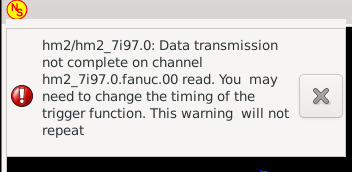Search Results (Searched for: )
- digiex_chris
- digiex_chris
17 Nov 2024 02:21
- IronManDylan
- IronManDylan
17 Nov 2024 02:10
Replied by IronManDylan on topic Fast Hole EDM from Hacked Parts
Fast Hole EDM from Hacked Parts
Category: General LinuxCNC Questions
- PCW

17 Nov 2024 00:29 - 17 Nov 2024 00:57
Replied by PCW on topic Strange motion offsets in one direction on one axis
Strange motion offsets in one direction on one axis
Category: General LinuxCNC Questions
- PCW

17 Nov 2024 00:12
Replied by PCW on topic Fanuc Serial Pulse Coders - Red cap servos, mesa 7i76e, how to?
Fanuc Serial Pulse Coders - Red cap servos, mesa 7i76e, how to?
Category: Driver Boards
- Lcvette

17 Nov 2024 00:06
- dbtayl
- dbtayl
16 Nov 2024 23:07
Replied by dbtayl on topic Strange motion offsets in one direction on one axis
Strange motion offsets in one direction on one axis
Category: General LinuxCNC Questions
- Bennett

16 Nov 2024 23:04
Replied by Bennett on topic Fanuc Serial Pulse Coders - Red cap servos, mesa 7i76e, how to?
Fanuc Serial Pulse Coders - Red cap servos, mesa 7i76e, how to?
Category: Driver Boards
- tommylight

16 Nov 2024 22:30
Replied by tommylight on topic linux keeps restoring to an old workspace state after reboot
linux keeps restoring to an old workspace state after reboot
Category: General LinuxCNC Questions
- swanie2000
- swanie2000
16 Nov 2024 22:09
Replied by swanie2000 on topic Are there no increase/decrease spindle speed buttons in Gmoccapy?
Are there no increase/decrease spindle speed buttons in Gmoccapy?
Category: Gmoccapy
- Bennett

16 Nov 2024 21:39 - 16 Nov 2024 22:21
Replied by Bennett on topic Fanuc Serial Pulse Coders - Red cap servos, mesa 7i76e, how to?
Fanuc Serial Pulse Coders - Red cap servos, mesa 7i76e, how to?
Category: Driver Boards
- anton610
- anton610
16 Nov 2024 21:36
Replied by anton610 on topic probe basic tool direction
probe basic tool direction
Category: QtPyVCP
- LabOuest
- LabOuest
16 Nov 2024 21:10
Replied by LabOuest on topic Remora - Does Analog input syntax exist?
Remora - Does Analog input syntax exist?
Category: Computers and Hardware
- Bennett

16 Nov 2024 20:49
Replied by Bennett on topic Fanuc Serial Pulse Coders - Red cap servos, mesa 7i76e, how to?
Fanuc Serial Pulse Coders - Red cap servos, mesa 7i76e, how to?
Category: Driver Boards
- PCW

16 Nov 2024 20:45 - 16 Nov 2024 20:51
Replied by PCW on topic Fanuc Serial Pulse Coders - Red cap servos, mesa 7i76e, how to?
Fanuc Serial Pulse Coders - Red cap servos, mesa 7i76e, how to?
Category: Driver Boards
- Bennett

16 Nov 2024 20:34
Replied by Bennett on topic Fanuc Serial Pulse Coders - Red cap servos, mesa 7i76e, how to?
Fanuc Serial Pulse Coders - Red cap servos, mesa 7i76e, how to?
Category: Driver Boards
Time to create page: 0.373 seconds

